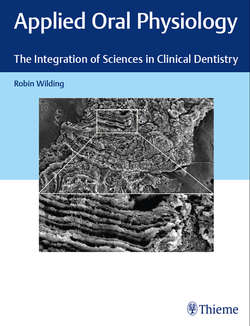Читать книгу Applied Oral Physiology - Robin Wilding - Страница 18
На сайте Литреса книга снята с продажи.
2.2.2 Tubules
ОглавлениеDentin is laid down by odontoblasts during tooth development. As the odontoblast retreats away from the secreted dentin, it leaves behind a process of the cell which remains into adult life, inside a fine tube or tubule. There is a greater density of tubules in cervical and root dentin than in coronal dentin (▶ Fig. 2.8 and ▶ Fig. 2.9).
The odontoblastic process continues to occupy most of the tubule into adult life. It extends the entire length of the dentinal tubule in the crown of the tooth but only about a third of the tubule in dentin around the neck of the tooth. There is less and less recognizable cell content in the tubule as the odontoblastic process gets further away from the cell body and nutrients. Furthest from the cell body the process has no organelles but some microcisterns and microfilaments. There is a space around the odontoblastic process which is occupied by fluid. This fluid is able to flow back and forth along the tubule and may transmit vibrations which convey information to sensors in the body of the odontoblast. Fluid movement within the tubule is thought to cause sensations of pain arising in the nerve endings in the dental pulp. The ease with which fluid is able to move through the dentinal tubules is referred to as dentin permeability.
Fig. 2.8 A SEM image (magnification × 300, window × 1,500) of dentin tubules viewed from the coronal pulp. The odontoblasts and their processes have been removed. Note the high density and large diameter of the tubules, which would make this area of the pulp–dentin highly permeability to fluid movement.
Fig. 2.9 A SEM image (magnification × 300, window × 1,500) of dentin tubules viewed from the root pulp. Note the higher density of tubules in comparison with coronal pulp in the previous image. This high density makes root dentin more permeable and therefore more sensitive to irritants than coronal dentin. The larger apertures are accessories to the apical root canal and may be responsible for spread of infection from the root pulp to the periodontium.
The odontoblastic process secretes dentin around the inner walls which is called peritubular dentin. This secretion continues throughout life but occurs more rapidly if there is mild irritation such as wear of the adjacent enamel or dental caries. However, peritubular dentin is also laid down in the absence of attrition, even in unerupted teeth. It is a feature of aging and is used by forensic dentists to determine the age of human remains.
Peritubular dentin reduces the tubule’s dimension, and may eventually block it completely (▶ Fig. 2.10). When this happens, the dentin is called sclerotic. The high mineral content of sclerotic dentin makes it translucent to light and is easily identified by holding up a ground section of a tooth up to the light.
Peritubular dentin restricts the fluid flow through the dentinal tubule and thus reduces tooth sensitivity from irritants such as wear of enamel and dentin, or loss of cementum covering root surfaces. When peritubular dentin completely blocks the tubule, it protects the pulp from the bacteria and bacterial products occupying more superficial layers of a carious lesion. As production of peritubular dentin occurs most rapidly in response to irritation, it is most pronounced in the dentin nearest the source of irritation at the tooth surface (caries or tooth wear).
Fig. 2.10 A SEM image of dentin which has been cracked in preparation so as to reveal dentin tubules. The dentin in this image was close to the amelodentinal junction. (Magnification × 300, window × 1,500). There are relatively few open tubules as most have been blocked with peritubular dentin. This zone of the pulp–dentin would have a very low fluid permeability.
